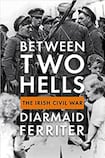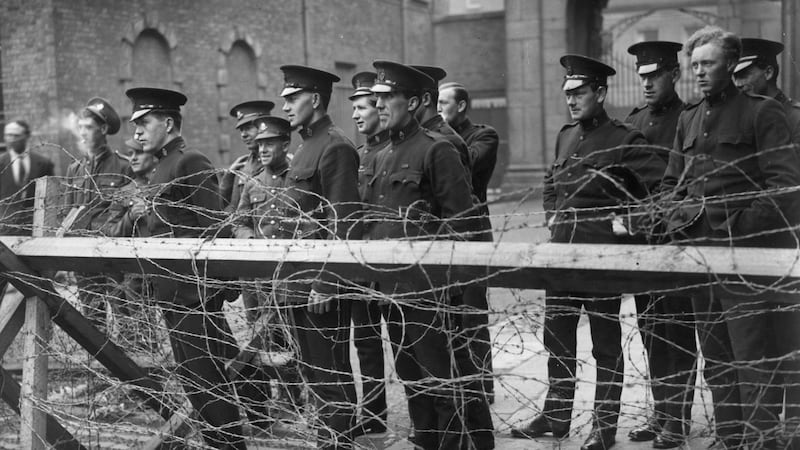
Between Two Hells is a fascinating exploration of the Civil War and its impact upon Ireland and Irish politics in the following half-century, rich in insights into how women and men experienced and responded to the calamity of the split and the tawdry violence which followed.
This absorbing study begs the question of why Irish politics did not develop along left/right, urban/rural lines akin to those seen in other newly independent states. The great divide instead emerged over symbols: a noxious oath of allegiance to the British crown, which de Valera magically detoxified in 1927 by terming it “an empty formula”; and a “Free State” within the empire rather than a “Republic” outside it (Dev had already unveiled his ingenious “external association” route around that obstacle during the secret Treaty debates). Despite chaos within and between counties along the 1920 border, and enduring misery for Northern nationalists, partition was not a decisive point of difference.
Ferriter maintains that “the Civil War was small-scale, but the rhetoric it generated was grandiose”. Rhetoric was also enduring: the cry “what about the 77?” could be heard in political debate well into the 1970s. (No one counted and recited the civilians and soldiers “executed” by the anti-Treatyites.) We forget at our peril that shrill Kevin O’Higgins was further soured by his father Thomas’s murder in January 1923, while the shooting of WT Cosgrave’s inoffensive uncle Patrick in September 1922 surely influenced the introduction of harsher measures to crush disorder.
Ferriter demonstrates that the extraordinary military service pensions archive is a catalogue of disappointment. Of more than 80,000 applicants, fewer than a quarter received a penny. Dependents of the fallen could also claim but, again, usually without success. The recorded privation among families of rank-and-file veterans of 1916-23 is shocking.
Ireland was a very poor place. In noting the apparently paltry sums awarded – £75 for a dead son was not unusual – we must remember that most poor families had no dead warriors to win them any financial support, however miserly. This makes it all the more anomalous, as Ferriter observes, that people such as Dan Breen – a salaried TD and recipient of a top IRA pension, as well as a wound award – should feel hard done by. In mitigation, Breen was also a vociferous champion of other applicants.
Opposite sides
Ferriter notes that “veterans were not generally in the business of denying references because they had taken opposite sides”. Min Ryan, wife of “Bloody Dick” Mulcahy, was an early applicant for a Cumann na mBan pension. Former Cumann na mBan officers, anti-Treatyites all, duly confirmed her claimed service. Colonel JV Joyce, reviled by republicans, dutifully attested to the claims of anti-Treaty men with whom he had served up to the truce.
Did such willingness to cross Civil War lines stimulate quiet reconciliation? Or was it evidence, particularly for those who had actually fought, that they had already put bitterness behind them?
The great questions which arise in this as in other civil wars centre not only on politics, ideology, state-building and military performance (where I believe the army did exceptionally well in its primary task), but on what the conflict represented. It was not a class war, an ethnic war, a religious war, a clash between economic and social radicals and conservatives. The only flickers of socialist activism – a few short-lived Soviets in Munster, a viciously suppressed farm labourers’ strike in Waterford – happened on the sidelines, noticed essentially for their rarity.
The strongest evidence of class-based militarism in 1922/23 was not in the new Ireland but in Belfast, where working-class loyalism took the lead in putting the nationalist minority firmly in its place. Ferriter also demonstrates the ubiquity of misogyny in Ireland, even though the anti-Treaty campaign was hugely dependent on women.

In the midst of conflict, the Cosgrave government prepared an intricate Land Act precisely to defuse and depoliticise land hunger. That was one manifestation of a remorseless process of state-building, largely unnoticed and unhampered by anti-Treatyites. Liam Lynch, content to sanction the killing of government TDs and civilian supporters in reprisal for draconian security laws, could never quite decide whether to attack the new unarmed Civic Guard. It quietly and quickly took root in civil society.
Dev is largely missing from these pages, just as he was during the conflict. Yet he was probably its greatest long-term beneficiary: it reduced militant republicanism to a rump. As notional “president”, he was guarded and cossetted, smuggled from one hiding place to another across the country. Kevin Barry’s family never forgot how, when sheltered in their Carlow home, he left his boots outside the bedroom door expecting them to be cleaned.
Not so much a Scarlet Pimpernel as an ineffectual spectre, Dev sought to make a virtue of his inability either to influence Liam Lynch or to call separately for republicans to stop fighting a war they could not win. It is hard to disagree with Tim Pat Coogan and others who have long criticised Dev. Having helped to ignite the conflagration, he sidled away as the fire grew hotter.
Stability
Ferriter’s work raises an issue which helps explain the surprising stability of independent Ireland after 1923. Ireland was remarkable for the lack of serious post-conflict sanctions upon the losers, except for an embargo of limited effectiveness on public service employment. They lost no civil rights. Most returned unhindered to their families, homes, farms and occupations. Cosgrave must be given credit for promoting this rapid, almost frenetic recourse to normality all round.
Ferriter rightly observes that, while republicans were embittered by unemployment and emigration after 1923, so too were many thousands of pro-Treatyite soldiers cast on the scrap heap from the summer of 1923 onwards. The brutal truth was that there were not enough jobs to go around even for the winners.
It was very different in Ulster. After the Treaty the cream of the northern IRA came south to prepare for the ill-conceived “northern offensive”. Many, like Johnny Haughey whose later travails Ferriter graphically outlines, joined the fighting for want of alternatives. Others, like my Co Down great-uncle Dan Rice, went home. He was promptly interned, being released only at Christmas 1924. In the Free State, the last of the anti-Treatyites who had fought and killed to the bitter end had been freed months earlier.
The book’s title borrows from an anti-Treaty Dáil speech in December 1921 by PJ Moloney TD, my great-grandfather. His family’s experiences of civil war were scarcely unique. His sons served on Liam Lynch’s staff, one as adjutant general and, briefly, deputy chief of staff. His stepson quit the RAF in 1922 to join the national army’s air service. His daughter, a Cumann na mBan officer, married into a prominent pro-Treaty IRA family while her brothers were on hunger strike. She always blamed Dev for the conflict; PJ worshipped him. Other families, including that of minister Eoin MacNeill, whose son Brian was murdered by government forces, experienced similar rifts.
Most wounds healed surprisingly quickly; a few never did.
Eunan O’Halpin is professor of contemporary Irish history at Trinity College Dublin











